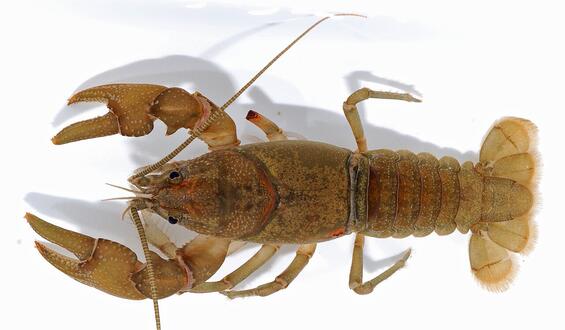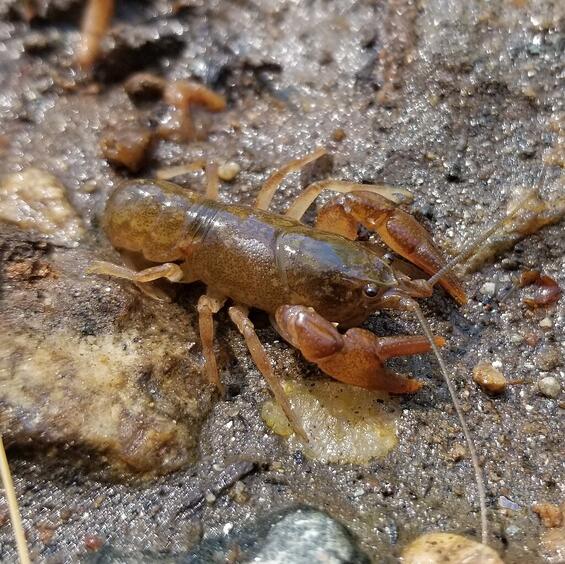- Scientific name: Cambarus bartonii
- Species of Greatest Conservation Need (MA State Wildlife Action Plan)
Description

A dorsal view of the Appalachian brook crayfish.
The Appalachian brook crayfish is a medium-sized (150 mm [6 in] in total length) crayfish in the crustacean order Decapoda. Adults tend to be a uniform brownish-tan color, varying to reddish-brown in older adults without any particular or outstanding markings. Juveniles are usually lighter colored. Tips of chelae (claws) and the rostrum (a projection between the eyes) margins in older adults can be purplish-red. Cambarus bartonii can be most easily separated from other crayfish in Massachusetts by the shape of the rostrum, which is quite broad, short, and blunt, with only a short acumen (point) produced anteriorly. Males and females are distinguished by the presence in males of highly modified pleopods (abdominal appendages) on the first two abdominal segments. The pleopods are unmodified in females. The tips of the first pair of pleopods or gonopods in reproductive males (form 1 males) are flattened and sharply bent.
One other species of crayfish in Massachusetts, big water crayfish (C. robustus), is similar to C. bartonii. C.robustus is known to occur in scattered drainages outside the range of C. bartonii in Massachusetts. In C. robustus, the rostrum is longer, narrower, and the acumen is more pronounced, and the species reaches a larger size than C. bartonii. See identification keys for definitive identification (e.g., Hobbs 1989, Smith 2000).
Life cycle and behavior
Little is known of the life cycle of Appalachian brook crayfish in Massachusetts, but other populations have been studied in its range. Females lay and carry 50-100 eggs under their abdomen as early as April and into June (Simmons and Fraley 2010). Hatched young stay with the female until they grow large enough to be free-living juveniles later in the summer months. It may take 2-3 years to reach sexual maturity and reproduce in following years (Hamr and Berrill 1985). Not all fully grown males can engage in sexual activity at a specific time because males of all species in the family Cambaridae undergo cyclic changes in the reproductive morphology. During the inactive phase, the sexual organs of the male are reduced and become non-functional. Once breeding has occurred, females become very inactive and find a location that will successfully conceal them during the egg-laying and brooding period. The species is considered a tertiary burrower.
Distribution and abundance

An Appalachian brook crayfish.
The Appalachian brook crayfish is widely distributed throughout eastern North America except in coastal regions and interior New England. In Massachusetts, the species is confined to the Hoosic River watershed. Within the watershed the species is mainly restricted to tributaries of the Hoosic River. Habitat within the mainstem of the Hoosic River is significantly altered, and therefore the species distribution may be restricted to more unaltered tributaries.
Habitat
Typical stream habitat for Appalachian brook crayfish.
The Appalachian brook crayfish occupies small to moderate-sized streams, springs and seeps, and occasionally lentic habitat (Hobbs 1989). The species may also be found burrowed in moist terrestrial habitat in colder months (Hartzell 2019). In Massachusetts, the Appalachian brook crayfish has been observed in upland and mountain streams, reaching an altitude of about 470 m (1550 ft). It occurs less commonly in unaltered sections of the Hoosic River where there is moderate to strong current. The species tunnels under large rocks and boulders which are well imbricated in the substrate, along undercut banks, under large wood and in burrows (Smith 2000).
Healthy habitats are vital for supporting native wildlife and plants. Explore habitats and learn about conservation and restoration in Massachusetts.
Threats
Threats to Appalachian brook crayfish include invasive crayfish species, alteration of streamflows, chemical pollutants, accelerated eutrophication, road salts, channelization, and habitat fragmentation by dams. Climate change may impact this species through changes in flow regimes, particularly more intense flooding events.
Conservation
Survey and monitoring
Standardized surveys are needed to update the status of this species in Massachusetts. Systematic surveys have not been applied since the mid-1990s. Efforts should target the Hoosic River watershed and surrounding watersheds west of the Connecticut River including the Housatonic, Westfield, and Deerfield River watersheds.
Management
Preventing the introduction and spread of invasive crayfish and protecting historical stream habitat is critical for the Appalachian brook crayfish. Controls over invasive species vectors including live fish bait shops, improper storage and disposal in educational environments (i.e., school classrooms), and the pet trade, should be put into place for Massachusetts. Preservation of riparian forests, restoration of channelized stream reaches, dam removal (in some cases), and reduction of chemical runoff from roads and industrial discharge will benefit Appalachian brook crayfish populations.
Research needs
Surveys should target historical but also include new streams to better understand its distribution and population status in Massachusetts. Further, surveys are needed to understand the distribution of non-native and potentially invasive crayfish species that may co-occur with Appalachian brook crayfish at the watershed-scale. Data can inform species risk assessments.
References
Hobbs, H.H. 2001. Chapter 23: Decopoda in J.H. Thorp and A.P. Covich (Ed.) Ecology and Classification of North American Freshwater Invertebrates. 2nd Edition. San Diego, California: Academic Press.
Hobbs H.H. 1989. An illustrated checklist of the American Crayfishes (Decapoda: Astacidae, Cambaridae and Parastacidae). Smithsonian Institution Press, Washington D.C.
Crocker, D.W. 1979. The Crayfishes of New England. Proceedings of Biological Society of Washington 92(2): pp 225-252.
Hamr, P., and M. Berrill. 1985. The life histories of north-temperate populations of the crayfish Cambarus robustus and Cambarus bartoni. Canadian Journal of Zoology 63(10): 2313-2322.
Hartzell S. 2019. Observation of a Cambarus bartonii bartonii (Common Crayfish) overwintering in a terrestrial winter microhabitat. Northeastern Naturalist 26(3):N35-N37.
Simmons J.W., and S.J. Fraley. 2010. Distribution, status, and life-history observations of crayfishes in western North Carolina. Southeastern Naturalist 9(3):79-126.
Smith, D. G. 2000. Keys to the freshwater macroinvertebrates of southern New England. Published by author. Sunderland, MA. 243 pp.
Contact
| Date published: | April 9, 2025 |
|---|